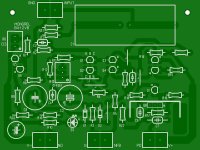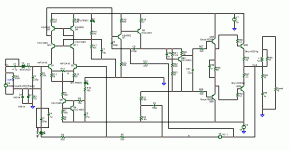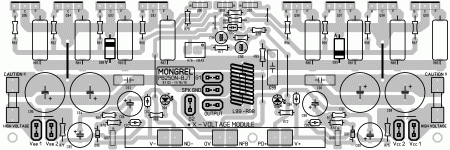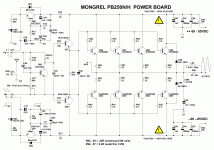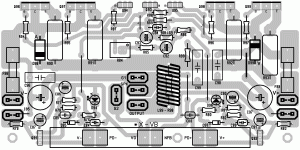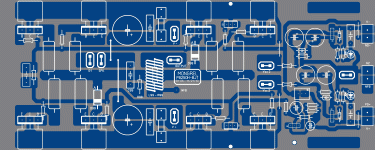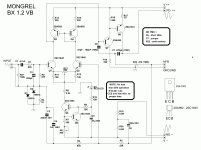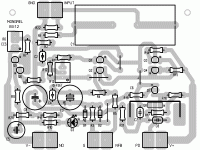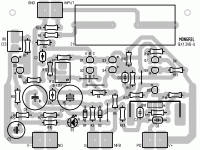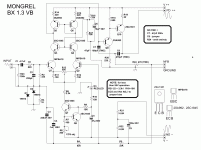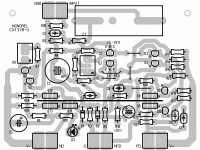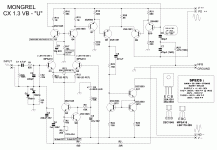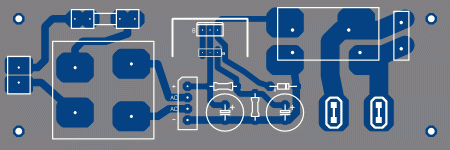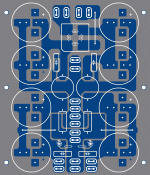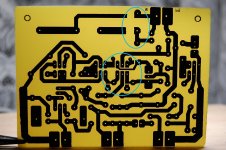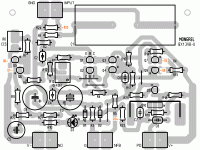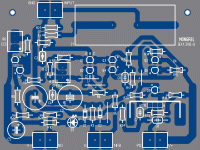Am I reading this correctly? It simulates at 0.08ppm distortion and yet it sounds nice!
Can you measure 20kHz distortion on the real amplifier?
For a two stage EF I am surprised at your chosen values for R79 R80, post818.
At 45Apk output, these base stoppers will drop ~4Vpk each.
Can you measure 20kHz distortion on the real amplifier?
For a two stage EF I am surprised at your chosen values for R79 R80, post818.
At 45Apk output, these base stoppers will drop ~4Vpk each.
Last edited:
Am I reading this correctly? It simulates at 0.08ppm distortion and yet it sounds nice!
Can you measure 20kHz distortion on the real amplifier?
And this is essentially Carlo's amp with E. stuarts TMC , crazy huh? I do not have anything to measure this low level at any frequency but it sounds VERY transparent. I did "misbias" an output stage on purpose to the point where a non-TMC'ed OPS would be audible and this improvement can definitely be heard.
Another "real world test" I did was to listen to the Class A drivers in isolation versus the full output stage ... all on a 220R resistor with my sony headphones. NO difference. DX has a real winner of an amp regardless of it's simplicity. Add better components , cap multipliers , and a 200w OPS and it's on the next level. 🙂 BTW ,with distortion this low or even 10X higher , the noise of the input pair is a bigger factor anyways ... hence the cascoded MPSA18's. (BX2) It also holds it's PPM tendencies right into nuclear levels (110v / p-p).
OS
edit... 45A ??? At 6-7A (realistic) less than 20mv drops across 100R. This OPS has been to hell and back , NO issues for 3 months (parties , once shorted out ,synthesizers, KIDS !!)
Attachments
Last edited:
OS:
i'm wondering if you have ever experimented with the null test for any of your builds (ala hafler xl280)? or even added the trimmer cap shown in the xl280 schematic for tweaking?
http://www.hafler.com/techsupport/pdf/XL-280_amp_man.pdf
btw, love watching you work! 😎
mlloyd1
i'm wondering if you have ever experimented with the null test for any of your builds (ala hafler xl280)? or even added the trimmer cap shown in the xl280 schematic for tweaking?
http://www.hafler.com/techsupport/pdf/XL-280_amp_man.pdf
btw, love watching you work! 😎
mlloyd1
yes, high value base stoppers will assist in helping the output stages survive an accidental short.edit... 45A ??? At 6-7A (realistic) less than 20mv drops across 100R. This OPS has been to hell and back , NO issues for 3 months (parties , once shorted out ,synthesizers, KIDS !!)
6-7Apk from a +-60 to +-70Vdc, implies a resistive 10r0 load.
What speakers are you using that never demand greater than 6-7Apk?
Os another goldmund killer version you should look at if you like Jfets is to use cfp. Using Jfets you need them to be cascoded and when used in bjt cfp you take care of memory distortion and ultra stable LTP. As the LTP gm has a hefty increase and the jfet is linearized because of the local feedback, distortion drops buckets, I think it will outperform your version if you use high gm jfets like 2sk170 or bf862 especially at high frequencies, 20khz. Another big plus is that the Jfet bjt cfp combined with cascode sound very good, to me the best LTP combination for my ears. It has practically no effect on the harmonic spectrum. On one of my car based amps using this topology I managed a measured .004THD at 20khz 150 W before clipping using 2sk363 as the Jfets. On the vas LTP no buffering is required and a little mod to the current mirror will get you symmetrical slew.
Hi Homemodder.. is it possible to draw a little sketch showing this.. Iam not too familiar with all the nice 3. letters ..like Jfet bjt cfp combined with cascode...
What trigs me is the dealing with memory distortion... which i understand as keeping voltage and current constant over the devices...(I may have understood it wrong) but i do like the sound of the lavardin products..🙂
OS:
i'm wondering if you have ever experimented with the null test for any of your builds (ala hafler xl280)? or even added the trimmer cap shown in the xl280 schematic for tweaking?
http://www.hafler.com/techsupport/pdf/XL-280_amp_man.pdf
btw, love watching you work! 😎
mlloyd1
A cap trimmer in with the shunted lead compensation , hafler is indeed strange. I DO like the input/voltage stage (to steal for my EX).
Andrew , "6-7A" is a normal peak , I am not crazy to drive at insane levels all the time. When I built my PB250 I ran 2 PAIR 8R pioneer speakers in parallel on a 95 degree (36c) day just to see the loading. This dragged my 75V rails down to 73+V and my cap multipliers were passing 20mv ripple to the GX's (not too bad). This would dim the lights to the music and shake any object to the floor .... way more than I really need - OVERKILL. I did not test further , as local law enforcement was called soon thereafter..

I have refined my BEST sounding amp , the BX .. (below) MPSA18 input stage , cascode ,CM and better layout. Input stage cascode is close but not "face to face" (not a gain stage - doesn't matter) for simplicity of layout.
There will be 2 BX's , 1 that is simple (LTP/CM-BX1.2) and the BX1.3F - all decked out .. usable with mpsa18 or LSK170 (EBC / cascode).
OS
Attachments
SPL and current demand of reactive load
Hi,
a pair of 4ohm 88dB/W @ 1m speakers driven to 40Vpk (very dynamic music) will demand upto 50Apk to give a peak SPL (no allowance for power compression) of about 106dB @ 2.5m listening distance.
dynamic music with an average to peak range of +20dB would produce an average SPL of 86dB. Loud but not as high as disco levels.
Hi,
a pair of 4ohm 88dB/W @ 1m speakers driven to 40Vpk (very dynamic music) will demand upto 50Apk to give a peak SPL (no allowance for power compression) of about 106dB @ 2.5m listening distance.
dynamic music with an average to peak range of +20dB would produce an average SPL of 86dB. Loud but not as high as disco levels.
Hi,
a pair of 4ohm 88dB/W @ 1m speakers driven to 40Vpk (very dynamic music) will demand upto 50Apk to give a peak SPL (no allowance for power compression) of about 106dB @ 2.5m listening distance.
dynamic music with an average to peak range of +20dB would produce an average SPL of 86dB. Loud but not as high as disco levels.
I do not have a SPL meter. I sat about 2M back from the 4 loudspeakers on my porch. Relative to the eagles concert I went to , the spl was WAY more intense. .. The fish tank inside had standing waves on it. I am glad LEO was called , I would have damaged my hearing. 😀
I have a several more PB250 EF2's in local clubs , they play "canned" bluegrass/classic rock at moderate levels in 2000 sq. ft. rooms (bar-dancefloor). OPS's just get moderately warm in this application even as they run commercial 4R speakers natively. I showed the owner the full extent of this amp and rattled all the glassware in the establishment , he said that was too much for the typical social setting.
As far as 50A ... whoa!! My PS only supplies 20A .. do you mean what the capacitors (85KuF) can discharge instantaneously ?? That I would believe.
OS
Last edited:
All done with a major upgrade to the mongrels. (power boards)
To satisfy the lust for power on two popular levels , I present the NEW - PB250N and PB120N.
The S-plan/Sprint outputs are in the "Mongrel" root folder of my site.
( "PB250N.zip" and "PB120N.zip" )
Sprint layout files are also in the mongrel root. (gerbers)
Examples are shown in the attachments below.
These are just refinements to my actual main house amp , which has served loudly and flawlessly for almost 4 months now.
All the BJT Output stages are dual supply capable ,the voltage modules stand upright allowing for a small footprint , and have large traces with VERY proper layout.
The last attachment shown below is the PB250H , which is my "lab" board to further development and will be in my genesis stealth case soon. This will be completed tonight (documentation).
OS
To satisfy the lust for power on two popular levels , I present the NEW - PB250N and PB120N.
The S-plan/Sprint outputs are in the "Mongrel" root folder of my site.
( "PB250N.zip" and "PB120N.zip" )
Sprint layout files are also in the mongrel root. (gerbers)
Examples are shown in the attachments below.
These are just refinements to my actual main house amp , which has served loudly and flawlessly for almost 4 months now.
All the BJT Output stages are dual supply capable ,the voltage modules stand upright allowing for a small footprint , and have large traces with VERY proper layout.
The last attachment shown below is the PB250H , which is my "lab" board to further development and will be in my genesis stealth case soon. This will be completed tonight (documentation).
OS
Attachments
Also done with Upgraded Voltage boards. (BX1.2-1.3 /CX)
We now have some excellent plug-ins for the 2 former power boards.
These have been tested , abused , and both the CX (in the barn -doghouse/mancave) and the BX (running in the house -PB250) are running now !!
These are also available on my site in the "mongrel" root. Included in the Zips are the LT simulation ,PCB,BOM,screen ... all HQ 600 DPI outputs. The 2 BX's are similar to carlos's blame amps but can run at 80V rails with TMC and other improvements. The CX is the goldmund killer , it sounds great and is quite durable as well (cold barn amp). All these modules , and the soon to be completed AX (pure blameless) are TMC - transitional miller compensation capable with adjustable current sources. Large audiophile input caps are also usable with these modules.
"BX1.2VB.ZIP" is similar to the "BLAME ES" and a VERY simple build.
"BX1.3VB.ZIP" is the cascoded MPSA18/JFET variant of the above.
"CX1.3VB-U" is the coolest 😎😎 symasym variant to date.
AX , And "LX" a tribute to professor Leach will be a comin' soon.
OS
We now have some excellent plug-ins for the 2 former power boards.
These have been tested , abused , and both the CX (in the barn -doghouse/mancave) and the BX (running in the house -PB250) are running now !!
These are also available on my site in the "mongrel" root. Included in the Zips are the LT simulation ,PCB,BOM,screen ... all HQ 600 DPI outputs. The 2 BX's are similar to carlos's blame amps but can run at 80V rails with TMC and other improvements. The CX is the goldmund killer , it sounds great and is quite durable as well (cold barn amp). All these modules , and the soon to be completed AX (pure blameless) are TMC - transitional miller compensation capable with adjustable current sources. Large audiophile input caps are also usable with these modules.
"BX1.2VB.ZIP" is similar to the "BLAME ES" and a VERY simple build.
"BX1.3VB.ZIP" is the cascoded MPSA18/JFET variant of the above.
"CX1.3VB-U" is the coolest 😎😎 symasym variant to date.
AX , And "LX" a tribute to professor Leach will be a comin' soon.
OS
Attachments
POWER and more POWER to the masses
OF course , to power all this madness a good softstart and mega power supply is needed. I revamped my PS100 CLC with the goodness of sprint and tomorrow
the NEW PS100 and SS20 softstart will be submitted.
The files will be "PS100N.zip" and "SS20.zip" ... also in the root of the mongrel folder. Extra large pads and lots of options for sourcing (universal cap footprint - 10mm 20mm-4pin) is standard.
OS
OF course , to power all this madness a good softstart and mega power supply is needed. I revamped my PS100 CLC with the goodness of sprint and tomorrow
the NEW PS100 and SS20 softstart will be submitted.
The files will be "PS100N.zip" and "SS20.zip" ... also in the root of the mongrel folder. Extra large pads and lots of options for sourcing (universal cap footprint - 10mm 20mm-4pin) is standard.
OS
Attachments
Hi Os,
You are so fast and prolific. Why you avoid to use ThermalTrak from ON??
I followed discussion oh other treads abot thermal stability but there was no final sugestion how to properly use incorporated diodes. For you is easy to order output transistor as a samples and try it. As you are so good and fast I am sure we wll get excellent news from you.
dado
You are so fast and prolific. Why you avoid to use ThermalTrak from ON??
I followed discussion oh other treads abot thermal stability but there was no final sugestion how to properly use incorporated diodes. For you is easy to order output transistor as a samples and try it. As you are so good and fast I am sure we wll get excellent news from you.
dado
BX1.3 VB tail current
Hi OS,
Thanks for sharing, I will build the BX1.3. I could not find MPSA18 locally so I will use the BC550 instead. I made some minor surgery to your BX1.3 VB so that the BC550 will be mounted face-to-face.
I will use small input cap so I modified the pads for C1 - the original trace for big cap look like a big antenna loop to me.
BTW, what is the target tail current if I measure the voltage across R8.
Cheers, Stanley
"BX1.3VB.ZIP" is the cascoded MPSA18/JFET variant of the above.
OS
Hi OS,
Thanks for sharing, I will build the BX1.3. I could not find MPSA18 locally so I will use the BC550 instead. I made some minor surgery to your BX1.3 VB so that the BC550 will be mounted face-to-face.
I will use small input cap so I modified the pads for C1 - the original trace for big cap look like a big antenna loop to me.
BTW, what is the target tail current if I measure the voltage across R8.
Cheers, Stanley
Attachments
Hi OS,
Thanks for sharing, I will build the BX1.3. I could not find MPSA18 locally so I will use the BC550 instead. I made some minor surgery to your BX1.3 VB so that the BC550 will be mounted face-to-face.
I will use small input cap so I modified the pads for C1 - the original trace for big cap look like a big antenna loop to me.
BTW, what is the target tail current if I measure the voltage across R8.
Cheers, Stanley
You should of told me before etching , I would of done the changes in a split second. Sprint is FAST !! tail current is 3.5ma total / 1.75ma per device.
OS
Hi Os,
You are so fast and prolific. Why you avoid to use ThermalTrak from ON??
I followed discussion oh other treads abot thermal stability but there was no final sugestion how to properly use incorporated diodes. For you is easy to order output transistor as a samples and try it. As you are so good and fast I am sure we wll get excellent news from you.
dado
They are too expensive and a passing "fad". The 3 pin to-3p and To-247 have lasted decades and will be here for a while. 🙁 boo for t-tracks. They won't give them for free and my NJW's are only $1.10 apiece when I buy 50.
OS
a passing "fad".
I think you may be right. I have a bunch of them and I may keep them as collector items

You have been busy! An amp version for each day of the week. I see one with a very familiar front end...

🙂
You have a bunch of error correction that can only make your amps sound cold and dry 😀
Kidding, of course.
Excellent work, the boards are very well laid out.
You should of told me before etching , I would of done the changes in a split second. Sprint is FAST !! tail current is 3.5ma total / 1.75ma per device.
OS
I edited the BX1.3 PCB jpg file before I etched the board. I used M$Paint & it took me less than 10 minutes. I found some problem with the BX1.3VB_overview.GIF file and it is a show-stopper.
Cheers, Stanley
I edited the BX1.3 PCB jpg file before I etched the board. I used M$Paint & it took me less than 10 minutes. I found some problem with the BX1.3VB_overview.GIF file and it is a show-stopper.
Cheers, Stanley
Tell me the "show stopper" so I can avoid it . Verbose!!!
 could it be the mpsa18/bc-xx input pairs??
could it be the mpsa18/bc-xx input pairs??OS
Last edited:
BX 1.3 Build Report
Hi OS,
I stuffed the board according the Overview & BOM file, I found a couple of problem with the BX1.3VB_overview.GIF file; a few components were labelled incorrectly.
Problem 1:
I could not adjust the tail current and I found the component labels of Q5&6 were transposed with Q7&8. I removed the four transistors & measured them again & they are OK.
Problem 2:
After I fixed problem 1, the amp could play music but the volume was much softer than normal. I measured the gain & it is around 40. I found that the input signal was attenuated by about 80% and found problem 2: the label for R23 & R24 were transposed and I had a 470R resistor across the input and no wonder the volume is soft.
The schmatics agrees with the BOM, so I inserted the correct(RED) label for these components in the attached Overview GIF file.
The BX1.3 is now playing music at normal volume & it is easy fatigue-free listening.
Cheers, Stanley
Hi OS,
I stuffed the board according the Overview & BOM file, I found a couple of problem with the BX1.3VB_overview.GIF file; a few components were labelled incorrectly.
Problem 1:
I could not adjust the tail current and I found the component labels of Q5&6 were transposed with Q7&8. I removed the four transistors & measured them again & they are OK.
Problem 2:
After I fixed problem 1, the amp could play music but the volume was much softer than normal. I measured the gain & it is around 40. I found that the input signal was attenuated by about 80% and found problem 2: the label for R23 & R24 were transposed and I had a 470R resistor across the input and no wonder the volume is soft.
The schmatics agrees with the BOM, so I inserted the correct(RED) label for these components in the attached Overview GIF file.
The BX1.3 is now playing music at normal volume & it is easy fatigue-free listening.
Cheers, Stanley
Attachments
Hi OS,
I stuffed the board according the Overview & BOM file, I found a couple of problem with the BX1.3VB_overview.GIF file; a few components were labelled incorrectly.
Problem 1:
I could not adjust the tail current and I found the component labels of Q5&6 were transposed with Q7&8. I removed the four transistors & measured them again & they are OK.
Problem 2:
After I fixed problem 1, the amp could play music but the volume was much softer than normal. I measured the gain & it is around 40. I found that the input signal was attenuated by about 80% and found problem 2: the label for R23 & R24 were transposed and I had a 470R resistor across the input and no wonder the volume is soft.
The schmatics agrees with the BOM, so I inserted the correct(RED) label for these components in the attached Overview GIF file.
The BX1.3 is now playing music at normal volume & it is easy fatigue-free listening.
Cheers, Stanley
Thanks , Stan. I corrected both problems and replaced "BX1.3VB.zip" .. silkscreen and overview updated (below). 😱😱
I will make a BC-xxx varient of the 1.3 , others have asked. Glad you like !! 🙂
Did it bias correctly?? , I have only used mine at 75 volt rails.
OS
Attachments
Last edited:
- Home
- Amplifiers
- Solid State
- The MONGREL (supersym II)

